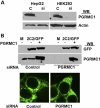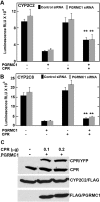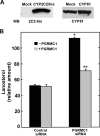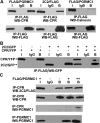Progesterone receptor membrane component 1 inhibits the activity of drug-metabolizing cytochromes P450 and binds to cytochrome P450 reductase
- PMID: 21081644
- PMCID: PMC3061357
- DOI: 10.1124/mol.110.068478
Progesterone receptor membrane component 1 inhibits the activity of drug-metabolizing cytochromes P450 and binds to cytochrome P450 reductase
Abstract
Progesterone receptor membrane component 1 (PGRMC1) has been shown to interact with several cytochromes P450 (P450s) and to activate enzymatic activity of P450s involved in sterol biosynthesis. We analyzed the interactions of PGRMC1 with the drug-metabolizing P450s, CYP2C2, CYP2C8, and CYP3A4, in transfected cells. Based on coimmunoprecipitation assays, PGRMC1 bound efficiently to all three P450s, and binding to the catalytic cytoplasmic domain of CYP2C2 was much more efficient than to a chimera containing only the N-terminal transmembrane domain. Down-regulation of PGRMC1 expression levels in human embryonic kidney 293 and HepG2 cell lines stably expressing PGRMC1-specific small interfering RNA had no effect on the endoplasmic reticulum localization and expression levels of P450s, whereas enzymatic activities of CYP2C2, CYP2C8, and CYP3A4 were slightly higher in PGRMC1-deficient cells. Cotransfection of cells with P450s and PGRMC1 resulted in PGRMC1 concentration-dependent inhibition of the P450 activities, and this inhibition was partially reversed by increased expression of the P450 reductase (CPR). In contrast, CYP51 activity was decreased by down-regulation of PGRMC1 and expression of PGRMC1 in the PGRMC1-deficient cells increased CYP51 activity. In cells cotransfected with CPR and PGRMC1, strong binding of CPR to PGRMC1 was observed; however, in the presence of CYP2C2, interaction of PGRMC1 with CPR was significantly reduced, suggesting that CYP2C2 competes with CPR for binding to PGRMC1. These data show that in contrast to sterol synthesizing P450, PGRMC1 is not required for the activities of several drug-metabolizing P450s, and its overexpression inhibits those P450 activities. Furthermore, PGRMC1 binds to CPR, which may influence P450 activity.
Figures










Similar articles
-
Progesterone receptor membrane component 1 modulates human cytochrome p450 activities in an isoform-dependent manner.Drug Metab Dispos. 2011 Nov;39(11):2057-65. doi: 10.1124/dmd.111.040907. Epub 2011 Aug 8. Drug Metab Dispos. 2011. PMID: 21825115
-
Dap1/PGRMC1 binds and regulates cytochrome P450 enzymes.Cell Metab. 2007 Feb;5(2):143-9. doi: 10.1016/j.cmet.2006.12.009. Cell Metab. 2007. PMID: 17276356
-
Progesterone receptor membrane component 1 (PGRMC1) binds and stabilizes cytochromes P450 through a heme-independent mechanism.J Biol Chem. 2021 Nov;297(5):101316. doi: 10.1016/j.jbc.2021.101316. Epub 2021 Oct 20. J Biol Chem. 2021. PMID: 34678314 Free PMC article.
-
S2R(Pgrmc1): the cytochrome-related sigma-2 receptor that regulates lipid and drug metabolism and hormone signaling.Expert Opin Drug Metab Toxicol. 2012 Mar;8(3):361-70. doi: 10.1517/17425255.2012.658367. Epub 2012 Feb 1. Expert Opin Drug Metab Toxicol. 2012. PMID: 22292588 Review.
-
PGRMC1 (progesterone receptor membrane component 1): a targetable protein with multiple functions in steroid signaling, P450 activation and drug binding.Pharmacol Ther. 2009 Jan;121(1):14-9. doi: 10.1016/j.pharmthera.2008.09.006. Epub 2008 Nov 1. Pharmacol Ther. 2009. PMID: 18992768 Free PMC article. Review.
Cited by
-
Progesterone Receptor Membrane Component 1 suppresses the p53 and Wnt/β-catenin pathways to promote human pluripotent stem cell self-renewal.Sci Rep. 2018 Feb 14;8(1):3048. doi: 10.1038/s41598-018-21322-z. Sci Rep. 2018. PMID: 29445107 Free PMC article.
-
Potential role of miR-139-5p in cancer diagnosis, prognosis and therapy.Oncol Lett. 2017 Aug;14(2):1215-1222. doi: 10.3892/ol.2017.6351. Epub 2017 Jun 8. Oncol Lett. 2017. PMID: 28789336 Free PMC article.
-
PGRMC1 effects on metabolism, genomic mutation and CpG methylation imply crucial roles in animal biology and disease.BMC Mol Cell Biol. 2020 Apr 15;21(1):26. doi: 10.1186/s12860-020-00268-z. BMC Mol Cell Biol. 2020. PMID: 32293262 Free PMC article.
-
The σ2 receptor: a novel protein for the imaging and treatment of cancer.J Med Chem. 2013 Sep 26;56(18):7137-60. doi: 10.1021/jm301545c. Epub 2013 Jun 18. J Med Chem. 2013. PMID: 23734634 Free PMC article. Review.
-
Insulin Receptor Plasma Membrane Levels Increased by the Progesterone Receptor Membrane Component 1.Mol Pharmacol. 2018 Jul;94(1):665-673. doi: 10.1124/mol.117.110510. Epub 2018 Apr 19. Mol Pharmacol. 2018. PMID: 29674524 Free PMC article.
References
-
- Ahmed IS, Rohe HJ, Twist KE, Mattingly MN, Craven RJ. (2010) Progesterone receptor membrane component 1 (Pgrmc1): a heme-1 domain protein that promotes tumorigenesis and is inhibited by a small molecule. J Pharmacol Exp Ther 333:564–573 - PubMed
-
- Ahn K, Szczesna-Skorupa E, Kemper B. (1993) The amino-terminal 29 amino acids of cytochrome P450 2C1 are sufficient for retention in the endoplasmic reticulum. J Biol Chem 268:18726–18733 - PubMed
-
- Backes WL, Kelley RW. (2003) Organization of multiple cytochrome P450s with NADPH-cytochrome P450 reductase in membranes. Pharmacol Ther 98:221–233 - PubMed
-
- Bridges A, Gruenke L, Chang YT, Vakser IA, Loew G, Waskell L. (1998) Identification of the binding site on cytochrome P450 2B4 for cytochrome b5 and cytochrome P450 reductase. J Biol Chem 273:17036–17049 - PubMed
-
- Cahill MA. (2007) Progesterone receptor membrane component 1: an integrative review. J Steroid Biochem Mol Biol 105:16–36 - PubMed
Publication types
MeSH terms
Substances
Grants and funding
LinkOut - more resources
Full Text Sources
Molecular Biology Databases
Research Materials

